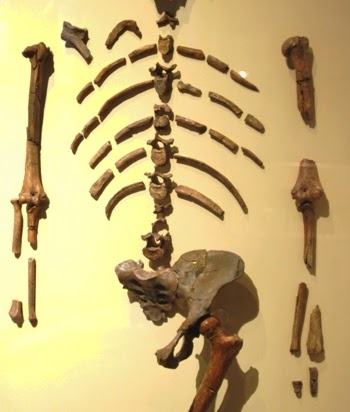"A team of scientists has announced that the famous “Lucy” skeleton, a specimen long heralded as proof of man’s evolutionary descent, likely includes at least one bone from a baboon.
Ever since its discovery in Ethiopia in 1974, the partial skeleton nicknamed “Lucy” has been touted by evolutionists as proof that humans evolved from ape-like ancestors. Eager to show evidence for Darwin’s theory, evolutionists claim that Lucy was a Hominid—an ape-like primate that possessed the ability to walk upright, like modern humans.
Today, natural history museums frequently depict Lucy as a part ape, part human creature, with long arms, an erect posture, and a small brain. Evolutionists maintain that the skeleton, which is claimed to
be 3.2 million years old, fills in crucial gaps in the human family tree.
However, many scientists, including those who believe in biblical creation, have long expressed skepticism toward the Lucy fossil. Sculptor and exhibit designer Doug Henderson wrote in a 2013 article for Answers in Genesis that depictions of Lucy are significantly influenced by biases and unfounded assumptions.
“Even though Lucy is fairly complete for a mammal fossil (47 of 207 bones found), the bones are mostly small fragments with many pieces missing,” Henderson wrote. “Other specimens have been found, but they are far more fragmentary. No matter how complete, all fossils must be interpreted. Some interpretation is always left to the imagination of the person doing the reconstruction.”
Last week, scientists announced that the famous skeleton includes at least one bone that likely came from a baboon. According to New Scientist, Gary Sawyer and Mike Smith at the American Museum of Natural History in New York, along with New York University’s Scott Williams, came to this conclusion after they analyzed the Lucy specimen and “noticed something odd.”
“Mike pointed out that one of the [vertebra] fragments, which no one, including me, had really paid close attention to, looked fairly small to fit with the rest of Lucy’s vertebral column,” Williams said.
“Baboons were a close match, both in shape and size,” Williams explained. “So we think we’ve solved this mystery. It seems that a fossil gelada baboon thoracic vertebra washed or was otherwise transported in the mix of Lucy’s remains.”
The researchers shared their findings at a meeting of the Paleoanthropology Society in San Francisco last week. Though evolutionists are downplaying the discovery as a minor mistake, others say these recent findings undermine the evolutionary dogma." ChristianNewsNetwork
Ever since its discovery in Ethiopia in 1974, the partial skeleton nicknamed “Lucy” has been touted by evolutionists as proof that humans evolved from ape-like ancestors. Eager to show evidence for Darwin’s theory, evolutionists claim that Lucy was a Hominid—an ape-like primate that possessed the ability to walk upright, like modern humans.
Today, natural history museums frequently depict Lucy as a part ape, part human creature, with long arms, an erect posture, and a small brain. Evolutionists maintain that the skeleton, which is claimed to
be 3.2 million years old, fills in crucial gaps in the human family tree.
However, many scientists, including those who believe in biblical creation, have long expressed skepticism toward the Lucy fossil. Sculptor and exhibit designer Doug Henderson wrote in a 2013 article for Answers in Genesis that depictions of Lucy are significantly influenced by biases and unfounded assumptions.
“Even though Lucy is fairly complete for a mammal fossil (47 of 207 bones found), the bones are mostly small fragments with many pieces missing,” Henderson wrote. “Other specimens have been found, but they are far more fragmentary. No matter how complete, all fossils must be interpreted. Some interpretation is always left to the imagination of the person doing the reconstruction.”
Last week, scientists announced that the famous skeleton includes at least one bone that likely came from a baboon. According to New Scientist, Gary Sawyer and Mike Smith at the American Museum of Natural History in New York, along with New York University’s Scott Williams, came to this conclusion after they analyzed the Lucy specimen and “noticed something odd.”
“Mike pointed out that one of the [vertebra] fragments, which no one, including me, had really paid close attention to, looked fairly small to fit with the rest of Lucy’s vertebral column,” Williams said.
“Baboons were a close match, both in shape and size,” Williams explained. “So we think we’ve solved this mystery. It seems that a fossil gelada baboon thoracic vertebra washed or was otherwise transported in the mix of Lucy’s remains.”
The researchers shared their findings at a meeting of the Paleoanthropology Society in San Francisco last week. Though evolutionists are downplaying the discovery as a minor mistake, others say these recent findings undermine the evolutionary dogma." ChristianNewsNetwork
Professing themselves to be wise, they became fools,
Romans 1:22

